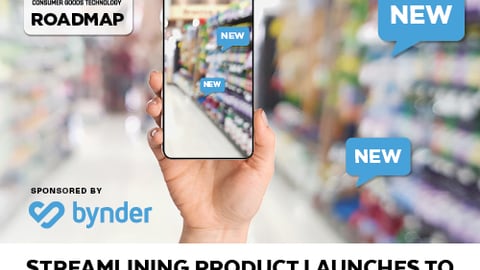Integrating Technology for Frictionless Product Launches
With digital transformation accelerating even faster through a global pandemic, new product launches are also expected to happen even faster, all while still staying on brand. And with this higher volume of content and data required to launch new products into the market comes a higher margin of error.
However, as some brands may find this challenging, others have used this as an opportunity to grow their business. New and innovative ways to engage with digital consumers have also surfaced, showing that consistency in brand messaging, product data, and imagery are all critical when meeting consumers online. What's more, there's an entire network of stakeholders like media, agencies, resellers, partners, and more who all need access to the right content and data that are critical to launch.
That's why we tapped into the expertise of VP of product marketing at Bynder Mark Tenniglo, to help consumer goods brands distribute and integrate this on-brand content quickly during launch, so they can use this as an opportunity for a more frictionless product launch process.
CGT: What are some of the challenges CGs face when preparing for product launches?
Tenniglo: The first challenge consumer goods companies have is knowing when to share sensitive product content. Not everyone has access to the same material, on the same platform, and email is a pain. So there’s always a risk that something doesn’t get shared, or something is shared, but to the wrong group, too early.
The other main challenge is getting to market quickly. Brands are expected to innovate, deliver, and sell products at a rapid rate in the new digital economy, so the great challenge is ensuring the content around the go-to-market approach is created and distributed in an equally agile manner, without breaking the bank of course.
CGT: What kind or kinds of technology can help, and how?
Tenniglo: Moving along the content lifecycle, it starts with digital asset management (DAM), where all product content around the launch can live centrally and be accessed by all stakeholders for fast go-to-market.
Next is the product information management (PIM) platform, which upholds all relevant product information and data such as SKU’s and colors, and follows those products around the digital ecosystem when a brand has a multi-layered approach to marketing and selling.
Last is the content management system (CMS), where the digital experience is built with the asset and product information building blocks, and what the customer will interact with.
These technologies each play a role on their own, but when integrated, CGs achieve a value multiplier allowing for end-to-end processes in the product launch lifecycle to happen in the cloud at rapid speed, which reduces manual errors and risk.
CGT: What should CGs look for in this type of/these types of solution(s)?
Tenniglo: Usability: Those in charge of the go-to-market launch expect a simple, intuitive platform that will help them do their jobs and requires minimal training, no extra resources, or hand-holding.
External collaboration functionality: No brand is an island. Every product launch will be dependent to some degree or another on external collaborators, whether they’re reselling the product or simply getting the word out in the media. Not factoring them into the tech stack is a huge miss. Enabling them to self-serve the product content they need has a significant impact on the speed with which the product can launch successfully.
On-brand: If technology is going to be used by all stakeholders, internal and external, to access brand content, the platform itself should be customizable as an extension of the brand identity.
CGT: What are some best practices to exercise when using technology for new product launches?
Tenniglo: Think of the holistic go-to-market approach. Too often, we see organizations focus only on a web experience, or only on reseller enablement, or only on social media. The same could be said of geographies. The best practice is to open up collaborative lanes between all these stakeholders, considering the holistic GTM approach that will ultimately benefit the customer.
The more integrated, the better. Ask your tech stack vendors to connect with each other to the fullest extent possible. Having an ecosystem mentality creates more automatic connection points, taking manual work and risk out of the product launch process and ensuring an on-brand, on-time launch.







